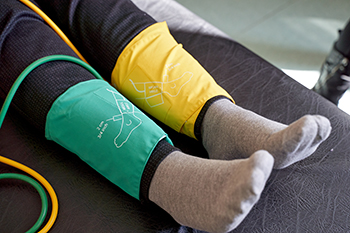Peripheral Artery Disease and Atherosclerosis

Peripheral arterial disease, or PAD, occurs when the arteries in your legs become narrowed or blocked due to a buildup of fatty deposits, known as atherosclerosis. This reduces blood flow to the lower limbs, which can cause pain, cramping, or fatigue during activities like walking. PAD not only affects mobility, but can also worsen atherosclerosis over time. As blood flow decreases, tissues in the legs and feet receive less oxygen and nutrients, leading to slower healing, higher risks of infections, and even tissue damage, in severe cases. If you have diabetes or smoke, your risk of PAD and its complications increases significantly. Early detection and management of PAD can help slow the progression of atherosclerosis and protect your health. If you are experiencing leg pain, numbness, or wounds that are slow to heal, it is strongly suggested that you see a podiatrist for evaluation and care.
Peripheral artery disease can pose a serious risk to your health. It can increase the risk of stroke and heart attack. If you have symptoms of peripheral artery disease, consult with Vincent, Vess from Fourth River Foot & Ankle. Our doctor will assess your condition and provide you with quality foot and ankle treatment.
Peripheral artery disease (PAD) is when arteries are constricted due to plaque (fatty deposits) build-up. This results in less blood flow to the legs and other extremities. The main cause of PAD is atherosclerosis, in which plaque builds up in the arteries.
Symptoms
Symptoms of PAD include:
- Claudication (leg pain from walking)
- Numbness in legs
- Decrease in growth of leg hair and toenails
- Paleness of the skin
- Erectile dysfunction
- Sores and wounds on legs and feet that won’t heal
- Coldness in one leg
It is important to note that a majority of individuals never show any symptoms of PAD.
Diagnosis
While PAD occurs in the legs and arteries, Podiatrists can diagnose PAD. Podiatrists utilize a test called an ankle-brachial index (ABI). An ABI test compares blood pressure in your arm to you ankle to see if any abnormality occurs. Ultrasound and imaging devices may also be used.
Treatment
Fortunately, lifestyle changes such as maintaining a healthy diet, exercising, managing cholesterol and blood sugar levels, and quitting smoking, can all treat PAD. Medications that prevent clots from occurring can be prescribed. Finally, in some cases, surgery may be recommended.
If you have any questions, please feel free to contact our offices located in Pittsburgh, White Oak, and McKeesport,PA . We offer the newest diagnostic and treatment technologies for all your foot care needs.
